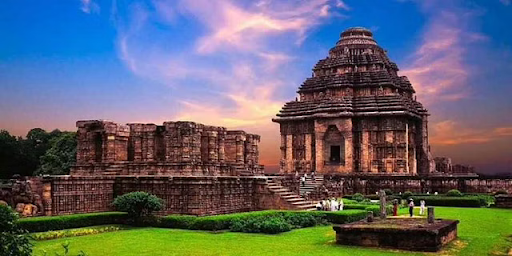Konark Temple
Why in News:
- Archaeological Survey of India (ASI) officials said that the restoration work is likely to be completed for the Konark Sun Temple’s newly-carved stones on the northern side of the jagmohan, or the assembly hall.
About

- The Konark or Konarak Sun temple is dedicated to the Hindu sun god Surya Surya, and conceived as a giant stone chariot with 12 wheels.
- It is located about 35 km northeast of the city of Puri on the coastline in the state of Odisha (earlier Orissa).
- It was built c. 1250 CE by King Narasimhadeva I (r. 1238-1264 CE) of the Eastern Ganga dynasty (8th century CE – 15th century CE).
- The temple in its present state was declared by UNESCO a World Heritage Site in 1984 CE.
Eastern Ganga Dynasty & Odisha Temple Architecture
- The Eastern Gangas established their kingdom in the Kalinga region in eastern India (present-day Odisha state) at the beginning of the eighth century CE.
- The greatest king of this dynasty was Anantavarman Chodaganga (1077 – 1147 CE), who ruled for about 70 years. He was not only a formidable warrior but also a patron of arts, and greatly favoured temple building.
- The great temple of the god Jagannatha at Puri, begun by him, stands as a brilliant monument to the artistic vigour and prosperity of Orissa during his reign’ .
- His successors continued the tradition, with the most notable being Narasimhadeva I who not only completed the construction of the Jagannatha temple but also the temple at Konarak.
Architectural style of Sun temple
- The temple follows the Kalinga or Orissa style of architecture, which is a subset of the nagara style of Hindu temple architecture.
- The nagara was among the three styles of Hindu temple architecture in India and prevailed in northern India, while in the south, the dravida style predominated and in central and eastern India, it was the vesara style.
- The main characteristics of the Orissa style are primarily two: the deul or the sanctum housing the deity covered by a shikhara, and the jaganamohana or the assembly hall.
Characteristics of the temple
- The Konarak temple, built entirely in stone, is in the form of a colossal chariot with twelve pairs of lavishly-ornamented wheels, drawn by seven richly-caparisoned, galloping horses. The 12 pairs of wheels represent the 12 months of the year.
- Between the wheels, the plinth of the temple is entirely decorated with reliefs of fantastic lions, musicians and dancers, and erotic groups.
- The vimana (principal sanctuary) was surmounted by a high tower with a shikhara (crowning cap), which was razed in the 19th century.
- To the east, the jahamogana (audience hall) dominates the ruins with its pyramidal mass. Farther to the east, the natmandir (dance hall), today unroofed, rises on a high platform. Various subsidiary structures are still to be found within the enclosed area of the rectangular wall, which is punctuated by gates and towers.
- The early Europeans traversing this sea referred to the Jagannatha temple as the ‘White Pagoda’ owing to its white plaster (now removed after restoration) and Konarak as the ‘Black Pagoda’.
To read about UNESCO and World Heritage Sites: https://officerspulse.com/unesco-world-heritage-sites/
Reference:
Subscribe
Login
0 Comments
